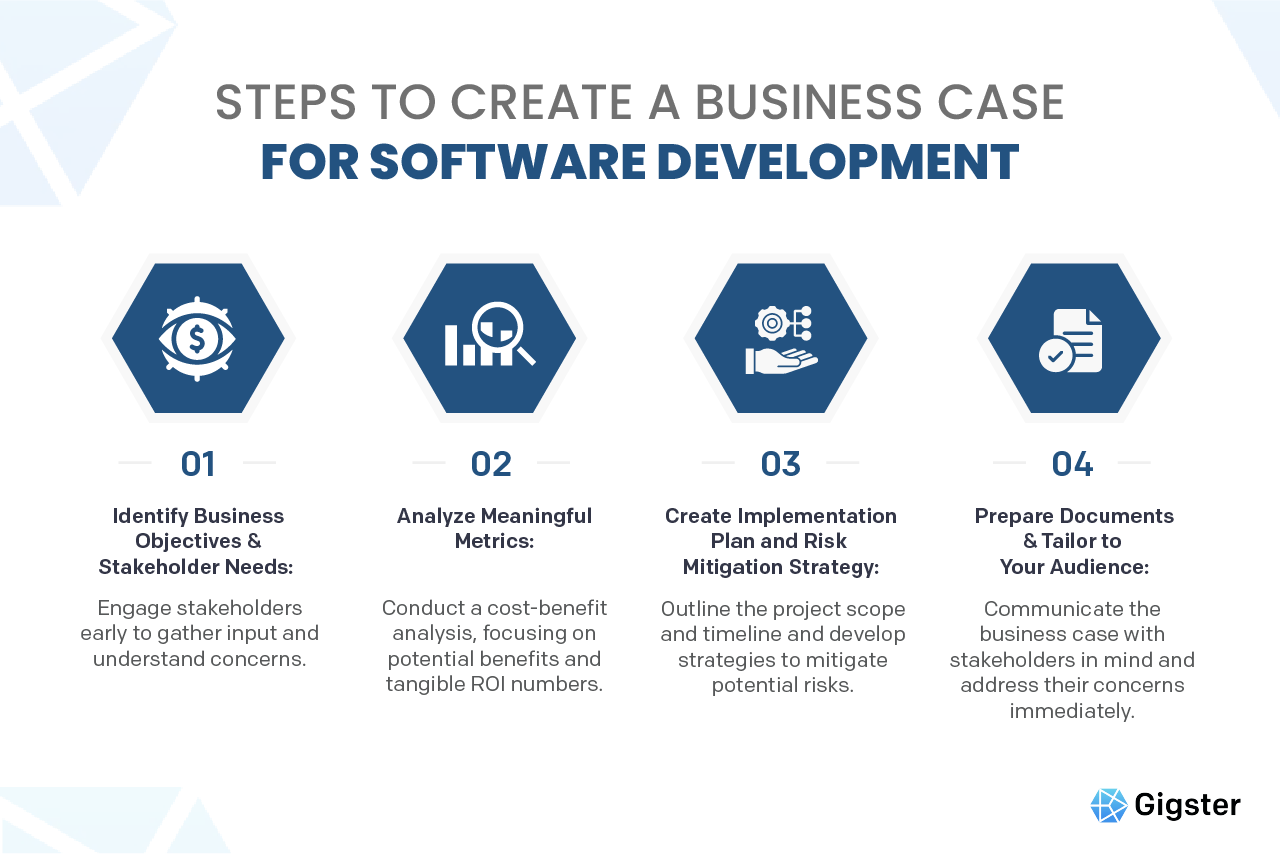
Getting your software development project approved starts with writing a compelling, informative business case. In addition to getting buy-in from business-side managers, the business case serves as the initial, high-level assessment of the project’s goals, objectives, issues, and opportunities.
At this stage, you may have a problem and know that it is probably going to be solved with a software product. Putting together a business case for custom software development is the next step in evaluating your potential solution and making a case to stakeholders for why it is the right course of action.
Many project sponsors don’t understand how much of a make-or-break document the business case can be. Failing to put together a complete and convincing business case could mean the project never gets approved for funding. Even worse, poorly defined needs and goals could lead the project to fail. A well-composed business case sets the foundation for a successful development project by clearly defining the key objectives and the financial measures that determine success.
What Does the Business Case Aim to Achieve?
The key question answered by a project’s business case is, “is it worth doing?” At a high level, it is a low-precision document used to achieve sign-in by project champions and funders.
If your organization is considering different solutions to the problem, the business case must answer, “is it the best possible solution compared to XYZ?”
Custom Development Services
However, the business case also serves several other important purposes as a high-level assessment of the project’s goals, objectives, issues, and opportunities. Conducting a cost-benefit analysis and economic feasibility study helps establish whether the proposed project benefits are valid. When the project is greenlit, the business case can be used to measure project success along with the SLA.
At Gigster, the Solutions Engineering team will often assist with the formalization of the business case to ensure it has everything needed for approval and successful development. This document is usually created as part of the needs assessment.
The Lean Canvas is a good unique value proposition-building framework. Use it as a template for considering the main problems, solutions, and unique value proposition of your project.

The first sentence of your business case should immediately and clearly convey the goals, audience, and differentiators of your project. Here is another useful framework for your business case description, using Gigster as an example:
- FOR: Innovative enterprises
- WHO: Have an impactful idea or business case
- THE: Gigster Innovation Support Team
- IS A: Strike team of flexible software development professionals with a passion for driving change among enterprise clientele
- THAT: Have proven, tested and repeatable impact from successful completion of challenging projects
- UNLIKE: Spending the extended time and money to build an internal team
- OUR SOLUTION: Gives confidence in the reliable delivery of solutions that drive global change.
Use this framework to clearly outline your solution and set the stage for an effective business case.
Use Your Business Case to Define the Goals of Your Software Development Project
Without a well-defined business case, it becomes difficult to establish and align meaningful project goals. This complicates the process of gathering requirements and choosing an appropriate software development company, potentially leading to project delays or assembling the wrong development team.
Your goals will depend on the specific software development project and your overall business objectives. Are you creating a new product, improving UX or productivity on an existing solution or process, or building new internal efficiencies? You may also be looking for expert software developers to help improve resilience or introduce new development capabilities.
One major priority for many tech leaders at the moment is reducing technical debt. According to McKinsey, companies in the bottom 20% of performers invest 50% less than the average on modernization to remediate tech debt. These companies are also 40% more likely to have incomplete or canceled tech-modernization programs compared to the top 20th percentile. Setting the goal to reduce tech debt will inform which metrics are needed to prove your business case.
Identify Meaningful Metrics for the Business Case
Once you understand the goals of your project, determine its financial value and feasibility. The exact metrics and research you conduct should be decided by your goals and by the concerns of your stakeholders.
Whatever metrics are relevant to your case, make sure they are translatable into tangible ROI. This may include comparing the ROI to development productivity or (in the case of tech debt) the cost of doing nothing. It is also important to analyze productivity versus complexity as software development projects become more complex. According to KPMG, 71% of project managers believe project complexity has increased.
Here are some of the main concerns you may need to address and the metrics to include:
- ROI: Most stakeholders will be concerned with ROI, so make sure your business case includes potential cost savings, cost-benefit ratios, payback periods, and other ROI-focused metrics.
- Risk: If your business case is focused on risk analysis and mitigation, include risk severity ratings, probability of occurrence, impact analysis, and the potential cost of doing nothing.
- User Experience: A UX-focused business case should include user engagement metrics, retention and churn rates, and business impact metrics such as conversion rates and customer lifetime value.
- Internal Operations: An internally focused business case should include process efficiency gains, resource utilization optimization, and employee productivity.
Tips for Building Effective Business Cases
While many of the above goals and metrics will be dependent on your specific business case, there are tips we’ve seen to ensure the greatest success. Here are a few things to keep in mind:

- Identify Business Objectives and Stakeholder Needs: Make sure to engage stakeholders early to gather input and understand concerns. Aligning the project objectives with your organization’s goals is key to gaining approval and seeing an ROI.
- Analyze Meaningful Metrics: Include relevant, well-researched metrics that address stakeholder needs. Avoid overstuffing the business case with data and only include the most relevant and impactful figures.
- Create an Implementation Plan and Risk Mitigation Strategy: Work with your development team to outline the project scope and timeline and develop strategies to mitigate potential risks. The implementation plan will be covered more fully in the project management plan and technical architecture document, but understanding the big-picture project requirements is helpful.
- Prepare Documents and Tailor to Your Audience: Communicate the business case with stakeholders in mind and address their concerns immediately.
Finally, work with the solutions engineering team to identify relevant metrics and opportunities and formalize the business case. At Gigster, we work with our clients during discovery because we understand how important the business case is to gaining approval and creating a roadmap for a successful development project. A strong business case helps provide clear goals and deliverables during project scoping to ensure the project stays within scope and meets its objectives.
If you’re looking to scope a new software development project, Gigster can help. Our low-cost MVP custom software development services quickly assemble an expert team to stress test your idea without committing to a full project. Contact us today with your idea to get started.
